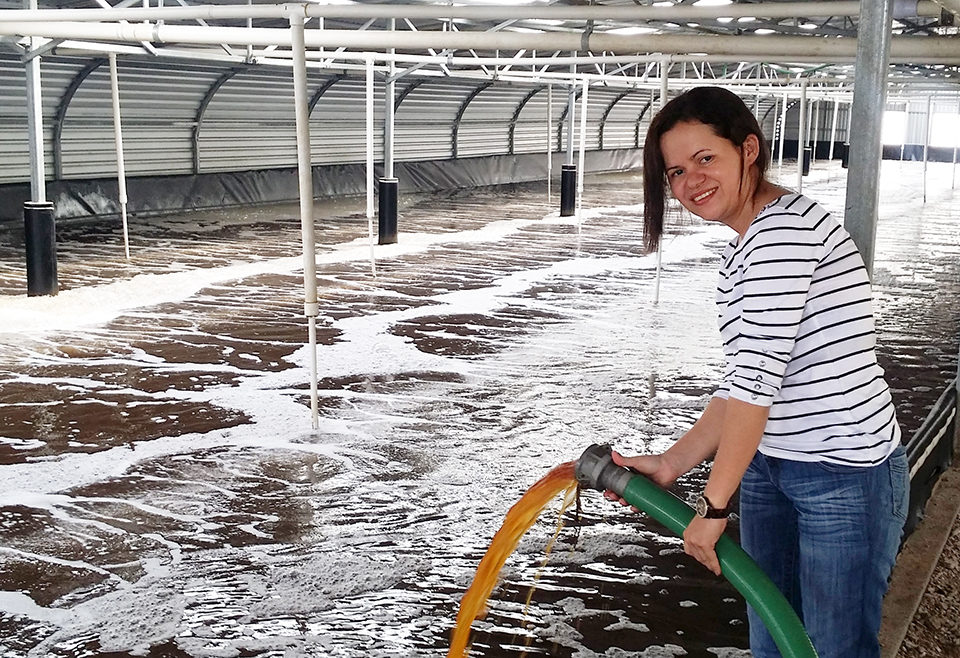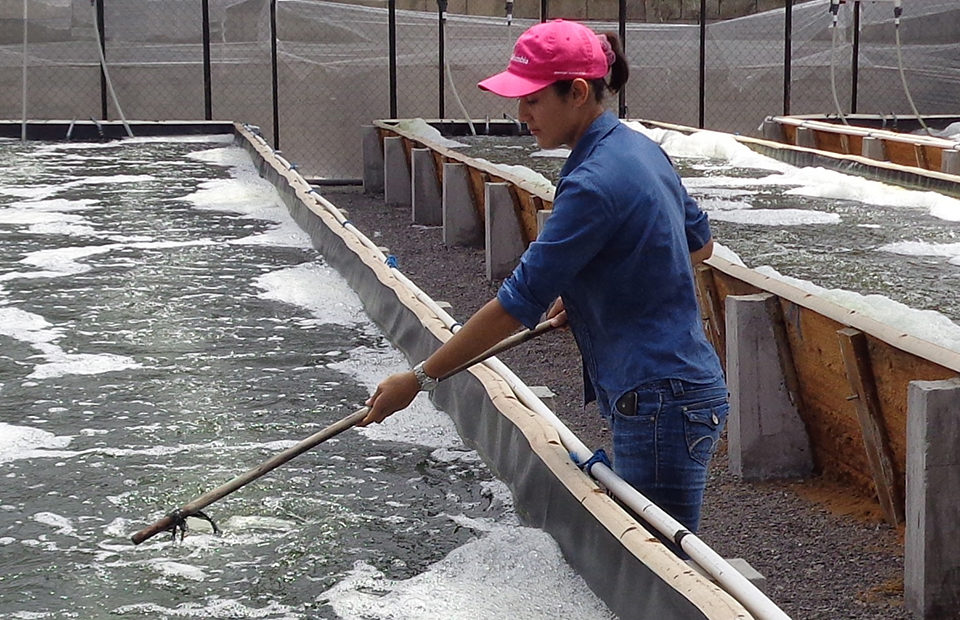Rotifers, copepods best candidates for secondary biomass production

Open pond aquaculture, where radiant light energy flows from the sun through a complex myriad of aquatic food webs to the final target animals, is a very efficient form of culture with significant untapped potential to improve efficiency beyond current levels by enhancing the conversion of free solar energy into secondary producer biomass. Natural food organisms rich in protein and other essential growth elements are very important food sources in ponds.
Honduras-based Grupo Granjas Marinas (GGM), a fully integrated shrimp producer with facilities from intensive biofloc nurseries to large extensive pond systems, is fine tuning what nature already has to offer by more efficiently producing zooplankton biomass in multi-phase ponds systems. To date, it has converted 400 ha of old ponds with plans to build out an additional 700 hectares (ha) in 2015.
Multi-phase inventory management system
For GGM, productivity is the single most important factor affecting the bottom line. Its new low-density, high-cycle multi-phase inventory management system (MIMS) is improving productivity by increasing growth and survival rates with shorter growout cycles. With a three-phase system, shrimp inventories are transferred from smaller to larger areas as the shrimp grow, thereby using production area more efficiently without increasing stocking densities.
Traditionally, GGM used a two-phase system to raise small juveniles in nurseries before transferring them to grow-out ponds. But this limited the size of the juveniles due to the logistics involved in transporting live biomass great distances. What MIMS does differently is minimize the transfer distance with a patented transfer system that facilitates moving large juveniles with minimum stress.
MIMS is a three-phase system with a central nursery pond configuration for easy transfer of large juveniles, the key productivity driver. The first phase utilizes a 1,200-metric ton (MT)-capacity multipurpose enclosed nursery for starting juvenile shrimp, as well as mass culture of rotifers and copepods to inoculate the central nursery ponds.
With an average survival of 74 percent in 350 ha of ponds harvested to date, MIMS has produced 15.0- to 16.0-gram shrimp in eight weeks. Animals with an initial average weight of 4.2 grams were initially stocked at a density of 8.1 juveniles/m2. The weekly growth rate was nearly 1.4 grams, and the harvest yield was 912.0 kg/ha.
MIMS is not only increasing culture efficiency, but also opening up new opportunities to develop environmentally cleaner feeding strategies. Large quantities of nutritious zooplankton biomass can be quickly produced to feed shrimp with positive implications for the economics and sustainability of the business.

Zooplankton management
Grupo Granjas Marinas believes that zooplankton management through large-scale sequential inoculation strategies in combination with short shrimp growth cycles can significantly increase the energy conversion from the sun toward shrimp production while reducing dependency on other sources of protein in feeds.
Shrimp ponds are complex food webs in which energy is passed from one trophic level to the next. As we learn more about their functional ecologies, our interest is drawn toward the incredible growth and reproductive capacity of the secondary producers and their important roles in the energy flow through pond ecosystems. Although algae are the principal primary producers that convert solar energy into organic compounds, secondary production is where the real untapped opportunity lies, because algae play such an important role as carriers of energy to higher trophic levels.
With the superior growth seen in ponds with higher copepod counts, GGM is convinced that the natural protein produced in the ponds is nutritionally superior to that present in formulated feeds. More emphasis is now being placed on the quality and composition of the cereal grain and feed distribution system throughout the company’s facilities.
Biomass management
The best candidates for secondary biomass production are rotifers and copepods, because they are capable of rapidly reproducing nutritious biomass and tend to dominate under GGM’s typical pond conditions. GGM’s biomass production methodology was initially developed at the shrimp hatchery in 40-MT raceways.
Its green technology team now raises rotifers up to 80 rotifers/mL and copepods to 16 copepods/mL in eight, 600-MT raceways. Final copepod counts reach 10 billion/raceway before the inoculation of 7-ha nursery ponds and replication up to 250 billion. The standing biomass can reach about 544 kg/ha in seven days. The rotifer production can reach nearly 2,270 kg/ha in four days. The GGM team is working to affirm the large-scale inoculation technology.
(Editor’s Note: This article was originally published in the September/October 2014 print edition of the Global Aquaculture Advocate.)
Author
-
Brian M. Boudreau
Director of Aquaculture Operations
Grupo Granjas Marinas
Barrio El Cortijo, Choluteca
Choluteca, Honduras
Tagged With
Related Posts

Health & Welfare
A holistic management approach to EMS
Early Mortality Syndrome has devastated farmed shrimp in Asia and Latin America. With better understanding of the pathogen and the development and improvement of novel strategies, shrimp farmers are now able to better manage the disease.

Intelligence
Adding value to tilapia to tap into U.S. market
New markets for tilapia and expansion of existing ones can be created by planning and implementing properly designed geographic strategies to meet discriminating consumer preferences. Low labor costs in most producing countries promotes value-adding by the production of fresh fillets.

Intelligence
A land grab for salmon (and shrimp) in upstate New York
The operators of Hudson Valley Fish Farm see their inland locale as a pilot to prove that land-based fish farming, located in close proximity to major metropolitan markets, can be successful.

Aquafeeds
A look at protease enzymes in crustacean nutrition
Food digestion involves digestive enzymes to break down polymeric macromolecules and facilitate nutrient absorption. Enzyme supplementation in aquafeeds is a major alternative to improve feed quality and nutrient digestibility, gut health, compensate digestive enzymes when needed, and may also improve immune responses.


